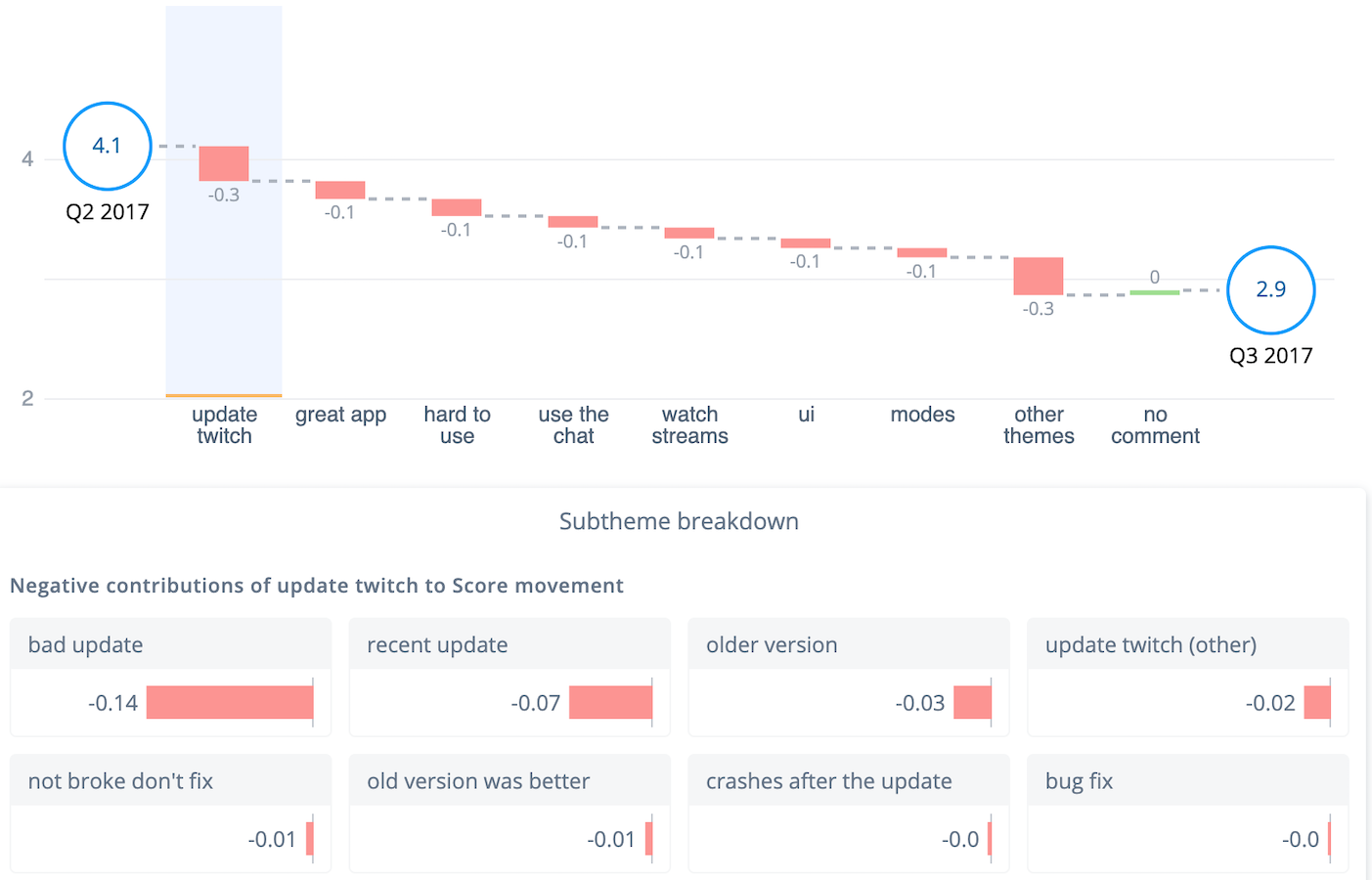
Feedback analytics can unleash the power of CX metrics by telling the “why” behind these scores. Learn how you can benefit from feedback analytics.

NPS, CSAT, CES...it doesn’t matter how many letters you throw out there or how many customer experience (CX) scores you get. If you don’t know what’s driving your CX metrics, it’s hard to replicate success, let alone find ways to improve.
Through comments in customer feedback surveys, social media conversations, call center dialogue, etc., your customers are often telling you how they feel about specific features, customer service quality, user experience, and more.
Feedback analytics helps you transform all this text into meaningful themes and analyze the impact of these themes on your CX metrics. In other words, if you want to be able to quantify and track what’s driving your CX scores, you need feedback analytics.
In this article, we’ll dive into how companies leverage customer feedback analytics. Specifically, we’ll look at:
The result: you’ll understand what needs to be done to improve your customer experience and achieve better business outcomes.

CX metrics aren’t just measures that marketers use to sound clever. Don’t let all the acronyms fool you, they’re usually not that complicated! CX metrics reflect how customers feel about interacting with your brand.
But CX metrics on their own only scratch the surface. The simplicity of CX metric scores mask the challenges of knowing what actions to take to improve your scores. If customers share opinions about your company, you should use that opportunity to dig in...even if the truth hurts.
Why? Because understanding the drivers behind your CX metrics and then intentionally focusing on how to improve your scores can help boost:
When customers have bad experiences, they often leave for competitors. But if you can find ways to improve your CX metrics such as customer satisfaction scores, you can retain and even grow revenue. A two-year study from fintech company Bumped found customer retention efforts boost revenue by an average of 40%.
Yet knowing scores isn’t enough. You need to go under the hood to see what’s prompting both good and bad experiences.
Customer loyalty is similar to customer retention, but think of loyalty as the souped-up version of retention. Because it’s one thing to come back as a repeat customer. It’s another thing to be loyal enough to evangelize a brand.
A KPMG study finds that 86% of loyal customers will recommend a brand to family and friends. So you don’t want to just know your customer loyalty scores. You want to know what's driving these metrics. Then you can bottle up that magic to keep the loyalty coming.
Once you’ve got customers hooked, it’s a lot easier to then cross-sell. Think about it. What would make you more likely to buy a cookbook that a restaurant sells? A great meal with great service? Or a lousy experience where the food was bland and you had to wait forever for a table?
Whether you want to cross-sell different lines of insurance, have customers add socks to their shoe orders, or anything else, providing a great customer experience can help you get there. A study by Bain & Company of online customer loyalty found that loyal customers are “more willing to expand their purchasing into new categories.”
Diving into the opinions behind your CX metrics can also help you improve brand equity. If customers hold your brand name in high regard, then everything else tends to get easier. Product launches, pricing strategies, cross-selling campaigns...you name it, brand equity can make a difference.
On the flip side, things like bad service or perceived quality issues can tank your brand equity. So if you get some low CX scores, you’re going to want to know what to fix ASAP. For example, a fashion brand might sell high-quality clothes, but a clunky mobile app could stain customer perception.
Put all this CX analysis together and what do you get? Deeper insight into customer needs, goals and challenges. That can then translate into business growth. Take a look at companies considered to be strong performers in terms of following customer engagement best practices: They’re more than twice as likely than other businesses to grow their market share, finds a study by Rosetta Consulting.

Clearly, CX metrics are a big deal. But let’s not get too deep into how to use feedback analytics to improve CX metrics just yet. First, it’s important to understand the symbiotic relationship between CX scores and feedback analytics solutions.
Below is a basic overview of each term:
CX metrics provide scores, while feedback analytics help tell the story behind those scores.
A CX metric might be your rating on the Apple App Store, for example. Feedback analytics might then look at the text within these App Store reviews to find themes and determine the impact of these themes on your rating.
Reviewing all feedback manually can be too complex and time-consuming to be worth it, let alone lead to decisive results. So, feedback analytics solutions typically use artificial intelligence to analyze text. But it doesn’t have to be Terminator-level AI.
Feedback analytics software generally uses a branch of AI known as natural language processing (NLP). The level of NLP sophistication runs on a spectrum, ranging from how human language can span baby talk all the way to highly educated adult speech.
In its simplest form, NLP can be used to figure out the sentiment of unstructured data. In this case, NLP basically looks at a string of text and assigns a tag of positive, neutral or negative.
The example below shows how the sentiment tools within a feedback analytics platform might classify text as having a positive or negative sentiment.

Now let’s go to the other side of the spectrum. A more complex form of NLP is doing thematic analysis of the data. That’s what Thematic does. With thematic analysis, important themes are extracted from feedback, which can be filtered by sentiment, most importantly, to see the impact of the themes on your scores.
The example below shows themes that are negatively contributing to this company's score between Q2 and Q3. It looks like they are having some serious issues successfully implementing software updates for their users.

If Todd from Cincinnati ruins your perfect 5-star app score, don’t get mad at Todd. Maybe Todd has some useful feedback that can help you improve your app.
But what do you do if you have hundreds or even thousands of Todds? And what if their feedback is spread across CSAT, NPS and other CX surveys? Use a feedback analytics solution.
Put another way, if you were to look at all the text-based feedback across customer support channels, you’d typically get information overload. The larger the company, the more feedback to process usually.
If your organization suffers from its data being heavily siloed, you should consider a feedback analysis solution that supports unified data analytics.
Advanced feedback analytics provides the critical role of:
Customers often leave comments that put the “why” behind their CSAT or NPS rating, for example. They might mention things like what was good/bad about their experience or a specific product/service feature that affected their score.
So, if you can use feedback analytics to make sense of all these scores, you can then zero in on what needs to be done next.
Whether you want to double down on areas that lift your scores, or you want to solve what’s dragging scores down, feedback analytics can help you figure out what to do.
For example, LinkedIn has used Thematic to pull back the curtain on the NPS for its Sales Navigator tool (see a dashboard screenshot below). The insights revealed that LinkedIn’s search functionality has a big impact on their NPS.
“It really shows the importance of getting that right, and understanding when a promoter is citing search, and when a detractor is citing search, what does that sound like? And we’re able within Thematic to then deep dive,” explains Allison Schoer, a market research professional at LinkedIn, in a webinar with Thematic.
Give yourself a break. Trying to analyze all the text feedback your company gets is generally too much for humans alone to handle. Instead, using a feedback analytics platform can help you determine drivers of positive and negative customer experiences.
But you don’t want to just analyze text on its own. Ideally, you will integrate your unstructured text feedback data with CX metrics and other customer data. A feedback analytics platform like Thematic makes this possible by using advanced AI, with human review, to pull out actionable insights.
By connecting both your structured and unstructured data to this type of feedback analytics tool, you can get clear business benefits. To name a few, you can:
Thematic centralizes customer feedback from reviews and surveys at scale and automatically generates analysis and reports for a detailed understanding.
The actionable insights come from using advanced AI, applying a thematic analysis approach. This delivers themes and sentiment insights in seconds, in an easily digestible format. It’s one of the many reasons over 7,000 professionals use Thematic to help them deliver better customer experiences and fuel growth.
You can find out more about analyzing customer feedback in these guides:
We also have some free feedback tools and resources that may help you:
Join the newsletter to receive the latest updates in your inbox.